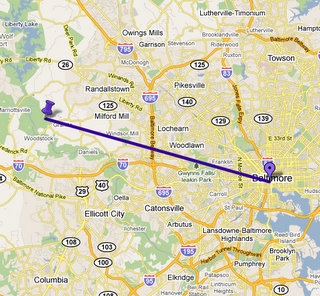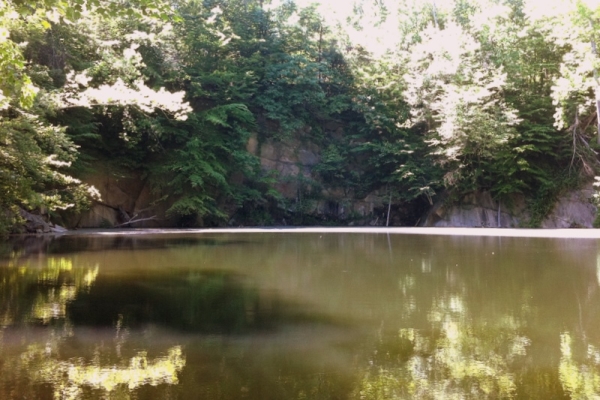Woodstock Granite
A Native Maryland Building Stone
NOTE: If your device can not display the entire
description, you can find the logging questions listed in the
hint.
What is a building stone? Well, any type of dense, massive rock suitable for use in construction can be defined as a building stone.
This Earthcache is one in a series of Earthcaches about Building Stones native to Maryland. Each one highlights a specific type of building stone, its origin, and an example of its use. Most of the quarry locations are closed or on private land nowadays, but you can still enjoy the unique properties of each by visiting a building, monument, or bridge constructed using them. I've done extensive research to identify with reasonable certainty the specific quarry or area that supplied the material for each of the places you will visit in this series.
Maryland has several distinct physio-graphic regions. Physio-graphic regions are broad-scale areas based on terrain texture, rock type, and geologic structure and history. In the US, they are generally broken down into three tiers: Divisions, Provinces, and Regions. Woodstock Granite comes from the area known as the Upland Section of the Piedmont Plateau Province.

You are standing in front of a building that is built with Woodstock Granite. The quarry for this stone is located about 14 miles WNW from here. Woodstock Granite is considered by many to the the very finest in the entire country and was of considerable economic importance. In the mid 1800's, the Smithsonian Institution in Washington, D.C. sent Dr. David Owen on an inspection tour of building material sources. On arriving here he reported: "For about a mile square at this locality is an outburst of quartzose, granite of magnificent quality, both as regards beauty of appearance, compactness of structure and uniformity of color, texture and composition. I have never seen anything superior in this country. Indeed, I doubt whether it can be excelled in any country. It cannot be surpassed for strength and durability by any building material in the world."

Stone Source Location
The granite from this area is a biotite granite of medium gray color and medium grain, and is extremely hard and durable. Granite, by definition, contains at least 20% quartz by volume. Additionally, this granite contains mainly potash feldspar, soda-lime feldspar, biotite, and muscovite. It is an igneous rock, meaning it is of volcanic origin. This granite was formed as magma pushed its way up through the surrounding Baltimore Gneiss and hardened.
One property that affects the durability of stone is how absorbant it is. Absorbed water that freezes can have a major negative effect on stone. An analysis of the Woodstock Granite shows that a 2-inch cube that weighs 345.5 grams will weigh 345.55 grams after a week of immersion in water. Because of this remarkably low absorption, the stone is virtually unaffected by repeated freezing and thawing. Additionally, the stone is extremely hard, with a crush strength of about 21,100 pounds per square inch. That far exceeds even high strength concrete.
The Building
The Fidelity and Deposit Corporation of Maryland built their headquarters at this location just over a century ago, and the company remains there under the same name. Meanwhile, the building has changed drastically. As first constructed, it consisted of eight floors of solid Woodstock Granite in the Commercial-Romanesque Style, with a tiled mansard roof of high pointed dormers, and a turret in the center. This roof line was substantially altered when it was widened and seven more stories were added between 1912 and 1915. The additional floors are framed with steel and faced with terra-cotta to match the stone. It is easy to see the outline of the original building even today, but you probably would never take notice. All of the exterior granite of this building came exclusively from the Fox Rock Quarry.
The Quarry
The Fox Rock Quarry was opened in 1836 and is just one of the many large granite quarries in "the most remarkable square mile in Maryland". The bottom of the quarry is perhaps 80 feet below the surface of the water. There was once a railroad that reached from the quarry, crossed the Patapsco River, and connected to the "Old Main Line of the B&O. Quarry operations ceased in the 1920s and the property is now part of the Patapco Valley State Park. The stone from this quarry is considered to be of the very highest quality and has been used in several notable buildings including the Library of Congress. If you feel like visiting, seek GC2YD2P - Fox Rock Quarry, a traditional cache at the quarry site.

Fox Rock Quarry 2011
To log this Earthcache:
Email me with the answers to the following questions. They can be found using the information above and by inspection of the building.
-
Rub your hand over the granite facing. Is it extremely rough, rough, smooth, or polished?
-
Look closely. Is the color uniform? What colors can you see?
-
What size are the individual grains of the stone?
-
In the early 1900 the building was extended and floors were added. That additional floors were covered in terra cotta to match the stone. What about the extended sides? Facing the corner door at Lexington Street, the original building extended down the left side for 6 of the 8 current window bays. The last 2 were part of the addition (the wall makes a slight bend here as well). Look at the material used to face the building around those last 2 windows. Do you think this is Woodstock Granite, or is the the Terra Cotta imitation? Describe any difference you can see between the 2 areas.
-
Optional: Post a photo in your log of you from across the intersection to the south east, with the building in the background and your GPS if possible (please no close-ups of the building).
Logs containing spoiler pictures will be deleted without warning.
You may post your log at any time, but emailed answers must follow within 7 days or your log will be deleted.
Be sure and visit the other EarthCaches in this series:
 Almshouse Amphibole Schist
Almshouse Amphibole Schist
 Cockeysville Marble
Cockeysville Marble
 Seneca Red Sandstone
Seneca Red Sandstone
References:
A Chronicle of the Most Unique Square Mile in Baltimore County, Morgan, 1967
Building stones and clay-products: a handbook for architects. Ries, New York, 1912
Granites of the southeastern Atlantic states. Watson, Washington, 1910
Maryland Geological Survey, Volume 2, Baltimore, 1898
Maryland Geological Survey (on-line)